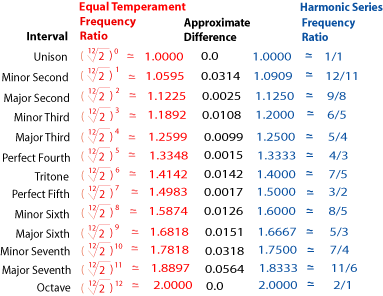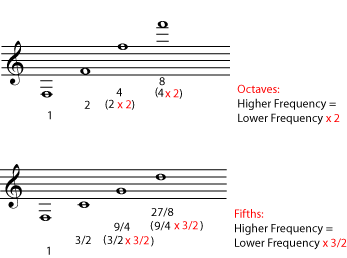| << Chapter < Page | Chapter >> Page > |
In equal temperament, the only pure interval is the octave. (The twelfth power of the twelfth root of two is simply two.) All other intervals are given by irrational numbers based on the twelfth root of two, not nice numbers that can be written as a ratio of two small whole numbers. In spite of this, equal temperament works fairly well, because most of the intervals it gives actually fall quite close to the pure intervals. To see that this is so, look at [link] . Equal temperament and pure intervals are calculated as decimals and compared to each other. (You can find these decimals for yourself using a calculator.)

Except for the unison and the octave, none of the ratios for equal temperament are exactly the same as for the pure interval. Many of them are reasonably close, though. In particular, perfect fourths and fifths and major thirds are not too far from the pure intervals. The intervals that are the furthest from the pure intervals are the major seventh, minor seventh, and minor second (intervals that are considered dissonant anyway).
Because equal temperament is now so widely accepted as standard tuning, musicians do not usually even speak of intervals in terms of ratios. Instead, tuning itself is now defined in terms of equal-temperament, with tunings and intervals measured in cents. A cent is 1/100 (the hundredth root) of an equal-temperament semitone. In this system, for example, the major whole tone discussed above measures 204 cents, the minor whole tone 182 cents, and a pure fifth is 702 cents.
Why is a cent the hundredth root of a semitone, and why is a semitone the twelfth root of an octave? If it bothers you that the ratios in equal temperament are roots, remember the pure octaves and fifths of the harmonic series.

Every octave has the same frequency ratio; the higher note will have 2 times the frequency of the lower note. So if you go up another octave from there (another 2 times), that note must have 2 x 2, or 4 times the frequency of the lowest note. The next octave takes you up 2 times higher than that, or 8 times the frequency of the first note, and so on.
In just the same way, in every perfect fifth, the higher note will have a frequency one and a half (3/2) times the lower note. So to find out how much higher the frequency is after a series of perfect fifths, you would have to multiply (not add) by one and a half (3/2) every time you went up another perfect fifth.
All intervals work in this same way. So, in order for twelve semitones (half steps) to equal one octave, the size of a half step has to be a number that gives the answer "2" (the size of an octave) when you multiply it twelve times: in other words, the twelfth root of two. And in order for a hundred cents to equal one semitone, the size of a cent must be the number that, when you multiply it 100 times, ends up being the same size as a semitone; in other words, the hundredth root of the twelfth root of two. This is one reason why most musicians prefer to talk in terms of cents and intervals instead of frequencies.
One well-known result of tempered tunings is the aural phenomenon known as beats . As mentioned above , in a pure interval the sound waves have frequencies that are related to each other by very simple ratios. Physically speaking, this means that the two smooth waves line up together so well that the combined wave - the wave you hear when the two are played at the same time - is also a smooth and very steady wave. Tunings that are slightly off from the pure interval, however, will result in a combined wave that has an extra bumpiness in it. Because the two waves are each very even, the bump itself is very even and regular, and can be heard as a "beat" - a very regular change in the intensity of the sound. The beats are so regular, in fact, that they can be timed; for equal temperament they are on the order of a beat per second in the mid range of a piano. A piano tuner works by listening to and timing these beats, rather than by being able to "hear" equal temperament intervals precisely.
It should also be noted that some music traditions around the world do not use the type of precision tunings described above, not because they can't, but because of an aesthetic preference for wide tuning . In these traditions, the sound of many people playing precisely the same pitch is considered a thin, uninteresting sound; the sound of many people playing near the same pitch is heard as full, lively, and more interesting.
Some music traditions even use an extremely precise version of wide tuning. The
gamelan orchestras of southeast Asia, for example, have an aesthetic preference for the "lively and full" sounds that come from instruments playing near, not on, the same pitch. In some types of gamelans, pairs of instruments are tuned very precisely so that each pair produces beats, and the rate of the beats is the same throughout the entire
range of that gamelan. Long-standing traditions allow

Notification Switch
Would you like to follow the 'Special subjects in music theory' conversation and receive update notifications?